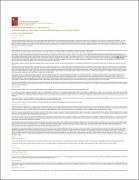| dc.contributor.author | Lule, Haruna | |
| dc.date.accessioned | 2019-02-15T11:22:18Z | |
| dc.date.available | 2019-02-15T11:22:18Z | |
| dc.date.issued | 2004-08 | |
| dc.identifier.issn | 2073-0683 | |
| dc.identifier.uri | http://hdl.handle.net/20.500.12280/1404 | |
| dc.description.abstract | Continuing medical education (CME) is one way of keeping health workers updated with the new developments and new insights in treatment and approaches to health issues. It also helps them remember what is forgotten. This study, conducted in Butambala Health Sub-district (HSD) by interviewing all the health workers on duty found that health workers knew the importance of CME. However, in 2002/2003, CME activities were not properly planned for while the selection of topics, participants and co-ordination of CME activities in the HSD left unmet needs in some areas of the medical field as well as ignoring some cadres of health workers. Despite all this, the general trend of events regarding
CME in the HSD was positive. The study recommended proper and participatory planning for CME preceded by training needs assessment, increase of budgetary allocations for CME and the creation of a CME registry for the HSD, as some ways to further improve the situation. | en_US |
| dc.language.iso | en | en_US |
| dc.publisher | Uganda Martyrs University, Department of Health Sciences | en_US |
| dc.rights | Attribution-NonCommercial-NoDerivs 3.0 United States | * |
| dc.rights.uri | http://creativecommons.org/licenses/by-nc-nd/3.0/us/ | * |
| dc.subject | Continuing Medical Education (CME) | en_US |
| dc.subject | Health Workers | en_US |
| dc.subject | Butambala Health Sub-district (HSD) | en_US |
| dc.title | Continuing Medical Education: Lessons From Butambala Health Sub-District | en_US |
| dc.type | Article | en_US |



